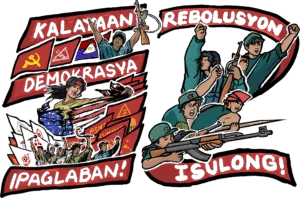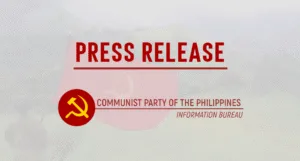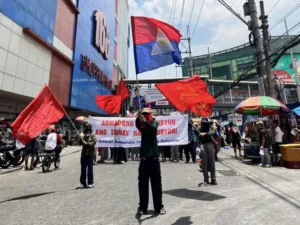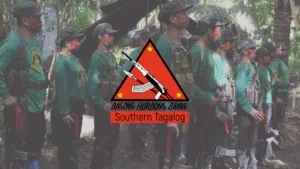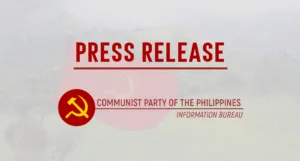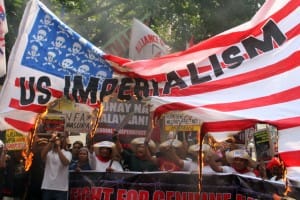By SIMON SANTIAGO
Regional Political Department
Merardo Arce Command, NPA-Southern Mindanao
The political department of the New People's Army in Southern Mindanao slams the 10th Infantry Division of the Armed Forces of the Philippines for deliberately installing detachments within civilian communities in the region, some only about 500 meters away from the populated areas.
This military encampment in populated areas has been affecting a total of at least 306,637 civilians mostly from the peasant and working classes in Southern Mindanao and the nearby provinces of Agusan del Sur and Surigao del Sur.
The AFP is deliberate in its effort to use civilians as 'human shields' around these detachments which is strictly prohibited under international humanitarian laws. It is also an act of cowardice as the AFP puts civilians, more often women and children, behind their line of fire.
The AFP has likewise used paramilitary leaders, especially in indigenous communities, to justify their encampment in civilian communities and to claim civilian support for their acts that grossly violate protocols of war. They conduct forced recruitment of civilians into paramilitary units and employ civilians as military assets to divide and sow terrorism in communities.
Based on the initial data gathered from the different revolutionary mass organizations in Southern Mindanao showed the following:
In Davao City, the military has nine detachments excluding the 10th ID-AFP headquarters in Panacan and the Task Force Davao headquarters in Sta. Ana Wharf. There are three detachments in Toril district, two in Calinan district and four in Paquibato district. These detachments are affecting about 76,766 civilians.
In Davao del Norte, the military has one detachment in Carmen and three in Asuncion, affecting about 3,305 civilians.
In Compostela Valley province, there are 78 military detachments installed in the municipalities of Compostela, Mabini, Maco, Maragusan, Mawab, Monkayo, Montevista, Nabunturan, New Bataan, Pantukan and Laak, affecting about 160,314 civilians.
In Davao Oriental, there are 28 military detachments installed in the municipalities of Baganga, Banaybanay, Boston, Caraga, Cateel, Lupon, San Isidro and Manay affecting about 59,424 civilians.
And in Trento in Agusan del Sur and Lingig in Surigao del Sur, the military has two detachments each affecting about 6,828 civilians.
(Please see attached matrix for the initial list of military detachments/encampments within civilian communities in the region and nearby provinces)
In the municipalities of Boston, Cateel, Lingig, Trento and Monkayo, detachments or enemy installations of the 72nd Cadre Battalion (CB), 23rd CB, 36th Infantry Battalion (IB), 25th IB, 1105th Police Mobile Group (PMG), 1401st PMG, Philippine National Police, Pulahan and private armies of Joel Brillantes are put up in a number of villages.
The initial list yielded a total of 123 enemy detachments situated within civilian communities.
This is a clear violation of the CARHRIHL (Part IV, Article 12) which clearly stipulates that "civilian population shall have the right to be protected against the risks and dangers posed by the presence of military camps in urban centers and populated areas." Likewise, it states (Part IV, Article 3, No. 8) that "maintaining, supporting and tolerating paramilitary groups such as armed religious fanatical groups, vigilante groups, private armed groups of businessmen, landlords and politicians, and private security agencies which are being used in land and labor disputes..," shall remain prohibited at any time and in any place whatsoever with respect to the civilians or those not taking active part in the hostilities; those who laid down their arms; the hors de combat; those persons deprived of their liberty for reasons related to the armed conflict; and relatives and duly authorized representatives of the aforementioned persons.
On the other hand, the Geneva Conventions of 1949 seeks the protection of civilian persons both in international and non-international armed conflicts.
The AFP, its paramilitary groups, private armies and private security agencies, and the PNP, are putting the lives of civilian populations in grave danger. Strongly aware that they are legitimate targets, the AFP/PNP intentionally and maliciously install detachments within civilian communities to make the latter as shields against tactical offensives from the revolutionary forces. The fascist AFP/PNP has been using this tactic in its ambitious bid to crush the revolutionary movement by June this year, and to stifle legitimate dissent under the vicious Oplan Bantay Laya.
Despite the US-Arroyo regime's empty boast of defeating the Communist Party of the Philipppines, the New People's Army and the National Democratic Front of the Philippines, it has, together with its fascist instruments, shown out and out cowardice by making the civilians as canon fodders.
While the AFP continuously demonizes the NPA with respect to civilians caught in the crossfire as what befell Memelyn Moreno and Rosalina Ponciano in Brgy. Sibajay in Boston, Davao Oriental, the fact remains: the AFP has put the civilians' lives at risk by installing detachments within civilian communities. In fact, it has allowed families of Cafgus to live inside the detachments as what is currently happening in a detachment in Brgy. Paradise in Paquibato.
Because of the US-Arroyo regime's murderous policies, the civilians are put in a very dangerous situation.
Despite this deliberate use of human shields by the AFP, the New People's Army, at all times, exerts all efforts and diligence to protect civilians in all its tactical offensives. In contrast to the AFP, the NPA has shown its utmost compliance with international humanitarian law.
The NPA challenges the 10th ID-AFP to respect the Comprehensive Agreement on Respect for Human Rights and International Humanitarian Law (CARHRIHL) which was signed between the NDFP and the GRP on March 1998; and the war protocols. Likewise, it challenges the military to spare the civilians and their communities and engage the Red fighters head-on according to rules of engagement that adhere to international humanitarian law and war protocols.
